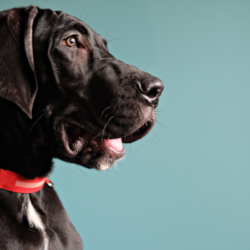Canine parvovirosis is a serious and potentially fatal viral disease caused by canine parvovirus type 2 (CPV-2). Primarily affecting puppies and young dogs, this highly contagious disease manifests itself as severe gastroenteritis. It causes vomiting, haemorrhagic diarrhoea and rapid dehydration. Early diagnosis and intensive treatment are essential to increase the chances of survival of infected animals. This article explores the key aspects of parvovirosis, including its symptoms, diagnostic methods and available treatment options.
What virus causes parvovirosis?
Canine parvovirosis is a recent infectious disease in dogs caused by canine parvovirus type 2(CPV-2). This virus is transmitted by direct contact or excrement. There is also a type 1 canine parvovirus(MVC), responsible for abortions and neonatal mortality in puppies under two months of age. Canine parvoviruses are highly resistant in the environment, making them difficult to eradicate. Vaccinated and cured dogs can remain symptom-free carriers.
Canine parvoviruses are single-stranded, non-enveloped DNA viruses with icosahedral symmetry and a genome of around 5,000 nucleotides. CPV-2 causes an often fatal gastroenteritis, particularly in young or old dogs. Since its isolation in the late 1970s, three variants have been identified: CPV-2, CPV-2a and CPV-2b, and more recently, CPV-2c. Canine parvovirosis manifests itself in two forms: intestinal and cardiac.
The intestinal form causes necrosis of the intestinal crypts, facilitating bacterial infection and potentially leading to septicaemia. The rarer cardiac form affects puppies infected in utero or shortly after birth, causing cardiac necrosis. Generalised infection, although rare, can also occur in newborn puppies, affecting several organs and causing haemorrhage.
Unvaccinated dogs and puppies are at greater risk. They can contract the disease when they come into nasal or oral contact with sick dogs or their excrement. Clothes, shoe soles and animal fur can carry the parvovirus and cause new infections.
What are the symptoms?
Affected dogs show their first symptoms between 3 and 7 days after infection: lethargy, followed by diarrhoea (often bloody), vomiting and fever. These symptoms lead to dehydration and superinfections may occur. Damage to the intestinal wall allows blood and proteins to pass into the intestines, causing anaemia, while endotoxins pass into the blood, causing endotoxaemia. White blood cell levels fall, further weakening the animal and potentially leading to circulatory shock and death.
In the late stages, dogs give off a distinctive odour. The intestinal form of parvovirosis can be confused with other infections, such as coronavirus or other enteritis, but it is generally more serious. The presence of bloody diarrhoea, a low white blood cell count and necrosis of the intestinal wall strongly suggest parvovirosis, especially in unvaccinated dogs. The cardiac form is easier to diagnose because of its characteristic symptoms.
The clinical signs of parvovirosis vary, but frequently include:
- Vomiting: repeated, sometimes with froth or blood.
- Diarrhoea: severe, watery, often bloody.
- Loss of appetite: refusal to eat.
- Lethargy: weakness, fatigue, lack of energy.
- Fever: increase in body temperature.
- Dehydration: dry skin, loss of elasticity, dry gums.
If you suspect symptoms of parvovirosis, consult a vet immediately. This severe gastroenteritis requires urgent intensive care and often hospitalisation for several days.
If left untreated, the mortality rate approaches 91%. With aggressive treatment, the survival rate can be as high as 80-95%, giving a mortality rate of 5-20%. For small dogs and young puppies of most breeds (Chihuahuas, Pomeranians, Rottweilers), the survival rate is much lower, between 20 and 50%
How is the disease diagnosed?
Canine parvovirus is diagnosed by observing the virus in excrement . Various methods are available, including ELISA (enzyme-linked immunosorbent ass ay) or haemagglutination and electron microscopy. PCR (polymerase chain reaction), available for CPV2, is used at a later stage, when the quantity of virus in the excrement is too low for ELISA to detect it.
A veterinarian makes the diagnosis after a full clinical examination. A parvovirus screening test is carried out using a stool sample. This gives a result within ten minutes. Blood tests are also carried out to assess levels of white and red blood cells.
Puppies aged between 6 and 12 weeks are the most susceptible to parvovirus and are the ones who die most often. At birth, the puppy has no immune defences. It acquires its first defences by drinking its mother’s colostrum, which is rich in maternal antibodies. The quantity of antibodies transferred depends on the quality and quantity of colostrum ingested, and the intestinal permeability of each puppy. These antibodies diminish over time, leaving the puppy with no passive immune protection before its own active immunity develops.
Maternal antibodies interfere with vaccines, justifying several vaccine injections in the puppy. Primary vaccination allows effective immune protection to develop.
What is the treatment?
The survival rate for canine parvovirus depends on how quickly the disease is diagnosed, the dog’s age and the effectiveness of the treatment. Treatment often requires full hospitalisation to manage severe dehydration and damage to the intestines and bone marrow. A test should be carried out as soon as parvovirosis is suspected to start treatment quickly and improve the chances of survival.
The ideal treatment includes intravenous administration of crystalloids or colloids, and injections of antiemetics and broad-spectrum antibiotics. Analgesics are used to relieve intestinal discomfort.
Whenever the puppy vomits or has diarrhoea, an equivalent amount of fluid is administered intravenously. Sometimes, blood plasma from a dog that has survived the disease is transfused to provide passive immunity to the sick dog.
Once the dog stops losing fluids, these are gradually stopped. A very light diet can then be gradually reintroduced. Oral antibiotics are administered depending on the white blood cell count and the dog’s ability to fight opportunistic infections.
Experimental treatments have shown promising results. The standard treatment remains intravenous fluid therapy. Parvovirus cannot be eliminated from the dog’s body. Treatment therefore focuses on managing symptoms, preventing dehydration and supporting the dog’s weakened immune system.
How can contamination be prevented?
Prevention is essential to protect dogs against parvovirosis, an extremely virulent and contagious disease. Vaccination should start at 5 to 6 weeks of age, with regular booster doses up to 14 to 22 weeks. Pregnant females should also be vaccinated as soon as possible to pass on their antibodies to the puppies.
The virus is highly resistant, surviving for over a year in excrement or soil.Bleach is the only common disinfectant effective against it. Puppies are generally vaccinated in series of doses, as soon as maternal immunity begins to decline. Older puppies receive three vaccinations 3 to 4 weeks apart.
A dog that has survived parvovirosis generally remains contagious for three weeks, or even six. The risk of infection is mainly linked to contamination of the environment by excrement. Owners of nearby dogs should have their pets vaccinated or check that they are sufficiently immune. The vaccine is only fully effective two weeks after administration, so contagious dogs should be quarantined.
It is important to follow the vaccination schedule recommended by your vet. Annual boosters are recommended to maintain immunity. Parvovirus is a serious threat, especially to puppies. That’s why we strongly recommend vaccinating dogs from an early age.





